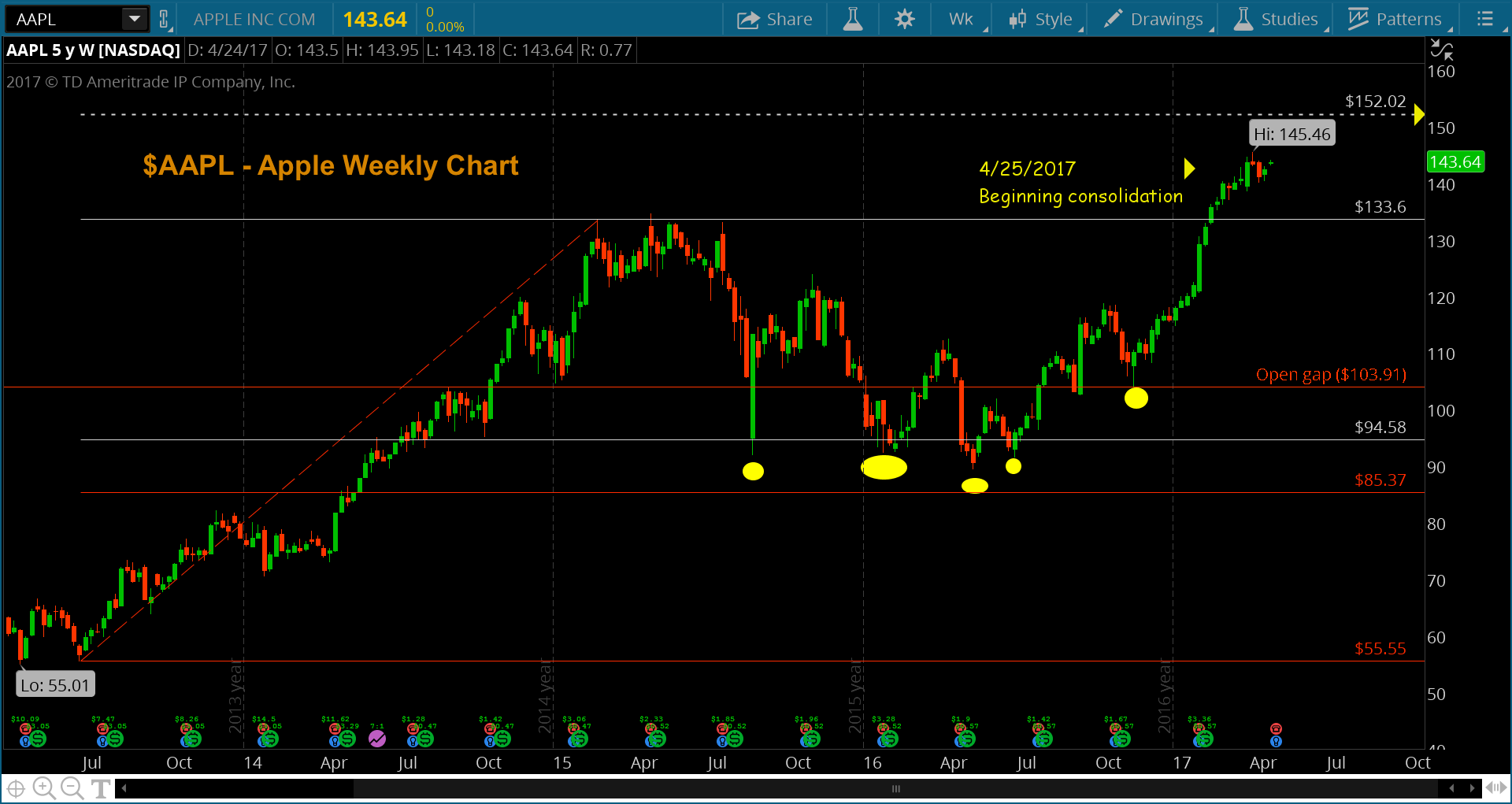Forecasting Apple Stock (AAPL) Price Levels: Key Indicators

Table of Contents
Analyzing Apple's Financial Performance
Understanding Apple's financial performance is paramount for forecasting its stock price. Analyzing key metrics provides valuable insights into the company's health and future growth potential.
Revenue Growth and Trends
Apple generates revenue from diverse streams, including iPhones, services (App Store, iCloud, etc.), wearables (Apple Watch, AirPods), and Macs. Examining the historical growth patterns of each segment is crucial.
- Year-over-Year (YoY) Growth: Consistent YoY revenue growth indicates a healthy and expanding business. Analyzing quarterly earnings reports provides a granular view of this growth.
- Product Lifecycle: Understanding the lifecycle of each product (introduction, growth, maturity, decline) helps predict future revenue streams. For example, the iPhone's mature stage requires innovation to maintain growth.
- Geographic Diversification: Analyzing revenue from different geographic regions reveals market penetration and potential for future expansion. A diversified revenue base generally indicates lower risk.
For instance, Apple's services segment has shown remarkable consistent growth, showcasing the company's ability to diversify beyond its reliance on hardware sales. Consulting resources like Apple's investor relations website and reputable financial news outlets (e.g., Bloomberg, Yahoo Finance) provides crucial data for this analysis.
Profitability and Margins
Profitability metrics are vital indicators of a company's financial health and its ability to generate returns for shareholders. Apple's high profit margins are a key factor in its stock valuation.
- Gross Margin: This indicates the profitability of Apple's products after deducting the cost of goods sold. High gross margins suggest efficient production and strong pricing power.
- Operating Margin: This reflects profitability after accounting for operating expenses. A consistent operating margin shows operational efficiency.
- Net Profit Margin: This represents the overall profitability after all expenses, including taxes and interest, are deducted. A high net profit margin is a positive sign for investors.
Analyzing trends in these margins provides insights into Apple's pricing strategies, cost management, and overall profitability. A decline in margins may suggest increased competition or rising costs.
Cash Flow and Debt
Apple's substantial cash reserves and free cash flow are significant factors affecting its stock price.
- Cash Reserves: Large cash reserves provide financial flexibility for investments, acquisitions, share buybacks, and dividend payments, all positive for shareholder value.
- Free Cash Flow: This indicates the cash generated from operations after accounting for capital expenditures. Strong free cash flow supports growth and dividend payouts.
- Debt Levels: Low debt levels reduce financial risk and enhance the company's ability to weather economic downturns.
Strong cash flow is a crucial indicator of financial stability and future growth potential. A healthy cash position allows Apple to pursue strategic initiatives and return capital to shareholders, positively influencing the stock price.
Assessing Market Sentiment and External Factors
Forecasting AAPL stock price levels also necessitates understanding market sentiment and broader economic conditions.
Industry Trends and Competition
The tech industry is dynamic, with constant innovation and competition.
- Competitive Landscape: Analyzing competitors like Samsung, Google, and other emerging tech companies is crucial. Their innovations and market strategies can impact Apple's market share.
- Technological Advancements: Emerging technologies (e.g., augmented reality, artificial intelligence) can create both opportunities and threats for Apple. Adapting to these trends is key for continued success.
- Regulatory Environment: Government regulations and antitrust concerns can also influence Apple's performance and stock price.
Economic Indicators and Macroeconomic Factors
Broader economic conditions significantly affect investor sentiment and stock prices.
- Interest Rates: Rising interest rates can increase borrowing costs and reduce investor appetite for riskier assets like technology stocks.
- Inflation: High inflation can erode purchasing power and impact consumer spending on discretionary items like Apple products.
- Recessionary Fears: Economic uncertainty can lead to decreased investor confidence and impact stock prices.
Analyst Ratings and Price Targets
Analyst ratings and price targets from reputable investment banks and research firms offer valuable insights, but should be considered alongside your own analysis.
- Consensus Estimates: While helpful, these shouldn't be the sole basis for investment decisions.
- Divergent Opinions: Note discrepancies among analyst ratings and understand the rationale behind different viewpoints.
- Independent Research: Always conduct your own thorough research and form your own conclusions.
Utilizing Technical Analysis for AAPL Stock Forecasting
Technical analysis complements fundamental analysis in forecasting AAPL's stock price.
Chart Patterns and Indicators
Chart patterns and technical indicators can identify potential price trends and reversals.
- Moving Averages: These smooth out price fluctuations and reveal underlying trends.
- RSI (Relative Strength Index): This measures the magnitude of recent price changes to evaluate overbought or oversold conditions.
- MACD (Moving Average Convergence Divergence): This identifies changes in momentum by comparing two moving averages.
- Support and Resistance Levels: These are price levels where the price has historically struggled to break through, indicating potential turning points.
It's crucial to remember that technical analysis is most effective when combined with fundamental analysis. Using both approaches provides a more comprehensive understanding of AAPL's price movements.
Trading Volume and Volatility
Trading volume and volatility provide insights into market sentiment and potential price changes.
- High Volume Breakouts: Significant increases in trading volume alongside price movements often signal strong trends.
- Volatility Clusters: Periods of high volatility can indicate increased uncertainty and potential for significant price swings.
Conclusion
Forecasting Apple stock (AAPL) price levels requires a holistic approach encompassing its financial performance, the broader market environment, and technical analysis. By meticulously analyzing revenue growth, profitability, cash flow, market sentiment, economic conditions, analyst ratings, and technical indicators, you can build a more robust forecast. Remember that no forecasting method is foolproof. By carefully considering these key indicators and conducting your own in-depth research, you can improve your ability to forecast Apple stock (AAPL) price levels and make informed investment decisions. Remember to always diversify your portfolio and consult with a financial advisor before making any investment decisions.

Featured Posts
-
 Claire Williams Actions Toward George Russell Controversy And Criticism
May 25, 2025
Claire Williams Actions Toward George Russell Controversy And Criticism
May 25, 2025 -
 Container Ship Grounding Unexpected Sight On Residential Property Cnn
May 25, 2025
Container Ship Grounding Unexpected Sight On Residential Property Cnn
May 25, 2025 -
 Melanie Thierry Et Raphael Surmonter Les Difficultes D Une Famille Nombreuse
May 25, 2025
Melanie Thierry Et Raphael Surmonter Les Difficultes D Une Famille Nombreuse
May 25, 2025 -
 Grand Slam Debut Alex Eala Set For Paris
May 25, 2025
Grand Slam Debut Alex Eala Set For Paris
May 25, 2025 -
 Ultima Hora La Muerte De Eddie Jordan Conmociona Al Mundo Del Motor
May 25, 2025
Ultima Hora La Muerte De Eddie Jordan Conmociona Al Mundo Del Motor
May 25, 2025
